Compact Bandwidth-Enhanced 180-Degree Phase Shifter Using Edge-Coupled Multi-Microstrip and Artificial Transmission Line
Abstract
:1. Introduction
2. Theoretical Analysis of the Reverse Shorted Coupled Line Prototype
- (1)
- Impedance matching analysis and drawback-1: When Port-2 is terminated with ZC, the input admittance of Port-1 (i.e., Yin) is
- (2)
- Amplitude/phase characterization and drawback-2: The amplitude/phase characteristics of Figure 1a are summarized in [20,21,22], where it is deduced that the signal–voltage ratio between Port-1 and Port-2 is constant at 1. Obviously, this illustrates that this reverse coupled-line structure has the frequency-independent property and can transmit signals with equal amplitude if line losses are not taken into account. Furthermore, the phase difference β between Port-1 and Port-2 can be derived as
3. Analysis of the Proposed Technologies in Novel 180° Phase Shifter
3.1. Effects and Selection of ECMML
3.2. Size Reduction in ATL
3.3. Precise Control of Phase Shift
4. Broadband 180° Phase Shifter Design and Its Performance
4.1. Simulated Performances of the Novel Switched-Network in Path 1 and Path 2
4.2. Performances of Complete 180° Phase Shifter with Measured Switching Transistors
5. Conclusions
Author Contributions
Funding
Data Availability Statement
Conflicts of Interest
References
- Hu, J.; Ma, K.; Mou, S.; Meng, F. A seven-octave broadband LNA MMIC using bandwidth extension techniques and improved active load. IEEE Trans. Circuits Syst. I Reg. Pap. 2018, 65, 3150–3161. [Google Scholar] [CrossRef]
- Kumar, A.R.A.; Sahoo, B.D.; Dutta, A. A Wideband 2–5 GHz Noise Canceling Subthreshold Low Noise Amplifier. IEEE Trans. Circuits Syst. II Express Briefs 2018, 65, 834–838. [Google Scholar] [CrossRef]
- Eom, S.-Y. Broadband 180° bit phase shifter using a λ/2 coupled line and parallel λ/8 stubs. IEEE Microw. Wirel. Compon. Lett. 2004, 14, 228–230. [Google Scholar]
- Lyu, Y.-P.; Zhu, L.; Wu, Q.-S.; Cheng, C.-H. Proposal and synthesis design of wideband phase shifters on multimode resonator. IEEE Trans. Microw. Theory Tech. 2016, 64, 4211–4221. [Google Scholar] [CrossRef]
- Zhou, J.; Qian, H.J.; Luo, X. Compact Wideband Phase Shifter Using Microstrip Self-Coupled Line and Broadside-Coupled Microstrip/CPW for Multiphase Feed-Network. IEEE Microw. Wirel. Compon. Lett. 2017, 27, 791–793. [Google Scholar] [CrossRef]
- Deng, X.-D.; Li, Y.; Wu, W.; Xiong, Y.-Z. A Compact W-Band Reflection-Type Phase Shifter with Extremely Low Insertion Loss Variation Using 0.13 µm CMOS Technology. Micromachines 2015, 6, 390–395. [Google Scholar] [CrossRef]
- Bhonkar, A.A.; Sutar, U. Overview of microstrip line phase shifter. Int. J. Adv. Res. Comput. Commun. Eng. 2016, 5, 465–469. [Google Scholar]
- Tsai, J.-H.; Tung, Y.-L.; Lin, Y.-H. A 27–42-GHz Low Phase Error 5-Bit Passive Phase Shifter in 65-nm CMOS Technology. IEEE Microw. Wirel. Compon. Lett. 2020, 30, 900–903. [Google Scholar] [CrossRef]
- Shin, G.S.; Kim, J.S.; Oh, H.M.; Choi, S.; Byeon, C.W.; Son, J.H.; Lee, J.H.; Kim, C.Y. Low insertion loss, compact 4-bit phase shifter in 65 nm CMOS for 5G applications. IEEE Microw. Wirel. Compon. Lett. 2016, 26, 37–39. [Google Scholar] [CrossRef]
- Amin, F.; Liu, Y.; Zhao, Y.; Hu, S. Compact and Low-Loss Phase Shifters and Multibit Phase Shifters Based on Inverted-E Topology. IEEE Trans. Microw. Theory Tech. 2021, 69, 2120–2129. [Google Scholar] [CrossRef]
- Anand, P.; Sharma, S.; Sood, D.; Tripathi, C.C. Design of compact reconfigurable switched line microstrip phase shifters for phased array antenna. In Proceedings of the 2012 1st International Conference on Emerging Technology Trends in Electronics, Communication & Networking, Surat, India, 19–21 December 2012; pp. 1–3. [Google Scholar]
- Lynes, G.D.; Johnson, G.E.; Huckleberry, B.E.; Forrest, N.H. Design of a broad-band 4-bit loaded switched-line phase shifter. IEEE Trans. Microw. Theory Tech. 1974, 22, 693–697. [Google Scholar] [CrossRef]
- Schiffiman, B.M. A new class of broad-band microwave 90-degree phase shifters. IEEE Trans. Microw. Theory Tech. 1958, 6, 232–237. [Google Scholar] [CrossRef]
- Guo, Y.; Zhang, Z.; Ong, L. Improved wideband Schiffman phase shifter. IEEE Trans. Microw. Theory Tech. 2006, 54, 1196–1200. [Google Scholar]
- Lyu, Y.-P.; Zhu, L.; Cheng, C.-H. Design and analysis of schiffman phase shifter under operation of its second phase period. IEEE Trans. Microw. Theory Tech. 2018, 66, 3263–3269. [Google Scholar] [CrossRef]
- Quirarte, J.L.R.; Starski, J.P. Novel schiffman phase shifters. IEEE Trans. Microw. Theory Tech. 1993, 41, 9–14. [Google Scholar] [CrossRef]
- Tang, C.-W.; Hsieh, Z.-Q. Design of a planar dual-band power divider with arbitrary power division and a wide isolated frequency band. IEEE Trans. Microw. Theory Tech. 2016, 64, 486–492. [Google Scholar] [CrossRef]
- Tsai, J.-H.; Lin, F.-M.; Xiao, H. Low RMS phase error 28 GHz 5-bit switch type phase shifter for 5G applications. Electron. Lett. 2018, 54, 1184–1185. [Google Scholar] [CrossRef]
- Sorn, M.; Lech, R.; Mazur, J. Simulation and experiment of a compact wideband 90° differential phase shifter. IEEE Trans. Microw. Theory Tech. 2012, 60, 494–501. [Google Scholar] [CrossRef]
- Yoon, H.-J.; Min, B.-W. Wideband 180° Phase Shifter Using Parallel-Coupled Three-Line. IEEE Microw. Wirel. Compon. Lett. 2019, 29, 89–91. [Google Scholar] [CrossRef]
- Matthaei, G.L.; Young, L.; Jones, E.M.T. Design of Microwave Filters, Impedance-Matching Networks, and Coupling Structures; McGraw-Hill: New York, NY, USA, 1964; pp. 214–220. [Google Scholar]
- Yoon, H.-J.; Min, B.-W. Two section wideband 90° hybrid coupler using parallel-coupled three-line. IEEE Microw. Wirel. Compon. Lett. 2017, 27, 548–550. [Google Scholar] [CrossRef]
- Eccleston, K.W.; Ong, S.H.M. Compact planar microstrip line branch-line and rat-race couplers. IEEE Trans. Microw. Theory Tech. 2003, 51, 2119–2125. [Google Scholar] [CrossRef]
- He, D.; Yu, M.; Li, J.; Yu, Z. An 18–50-GHz Double-Balanced GaAs Mixer Using Novel Ultrawideband Balun. IEEE Microw. Wirel. Technol. Lett. 2023, 33, 723–726. [Google Scholar] [CrossRef]
- He, D.; Yu, M.; Cui, N.; Tan, C.; Yu, Z. Analysis and Design of Novel 1800 Hybrid for U-Band Monolithic Subharmonic Mixer in 0.15-μm GaAs pHEMT Technology. IEEE Trans. Circuits Syst. II Express Briefs 2023. [Google Scholar] [CrossRef]
- Yu, X.; Chen, J.; Feng, L.; Zhu, L.; Liu, H. Synthesis Design of Wideband Phase Shifters Using Coupled-Line Structure. IEEE Microw. Wirel. Compon. Lett. 2022, 32, 515–518. [Google Scholar] [CrossRef]
- Wong, Y.S.; Zheng, S.Y.; Chan, W.S. Multi-way and poly-phase aligned feed-forward differential phase shifters. IEEE Trans. Microw. Theory Tech. 2014, 62, 1312–1321. [Google Scholar] [CrossRef]
- Zhang, W.; Shi, J.; Wu, G.; Lin, L.; Xu, K. A Balanced Substrate Integrated Waveguide Phase Shifter with Wideband Common-Mode Suppression. Micromachines 2023, 14, 285. [Google Scholar] [CrossRef]
- Han, Y.; Li, R.; Qiao, L.; Wei, F. Balanced Wideband Quasi-Schiffman Phase Shifters Based on Slotlines. IEEE Trans. Circuits Syst. II Express Briefs 2022, 69, 4283–4287. [Google Scholar] [CrossRef]
- Yuan, Y.; Zeng, J.; Zhang, D.; Li, J.; He, D.; Tan, C.; Yu, Z. An X-Band High-Accuracy GaAs Multifunction Chip with Amplitude and Phase Control. IEEE Access 2023, 11, 3872–3880. [Google Scholar] [CrossRef]
- Zeng, J.; Xie, C.; Zhang, D.; Feng, J.; Tan, C.; Yu, Z. A wideband accurate compact 6-bit phase shifter in 0.15-µm GaAs technology. Microw. Opt. Technol. Lett. 2023, 65, 534–540. [Google Scholar] [CrossRef]

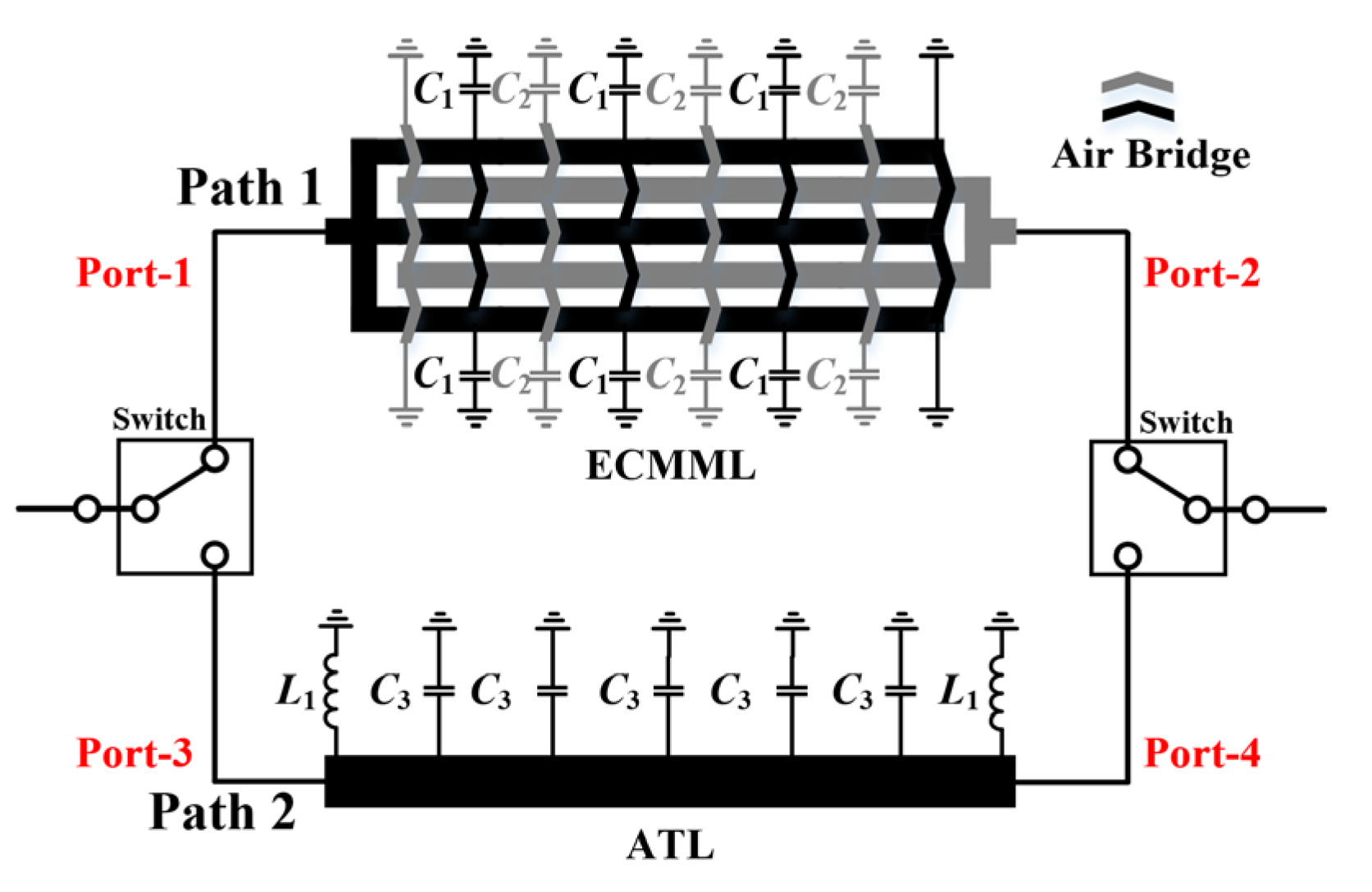


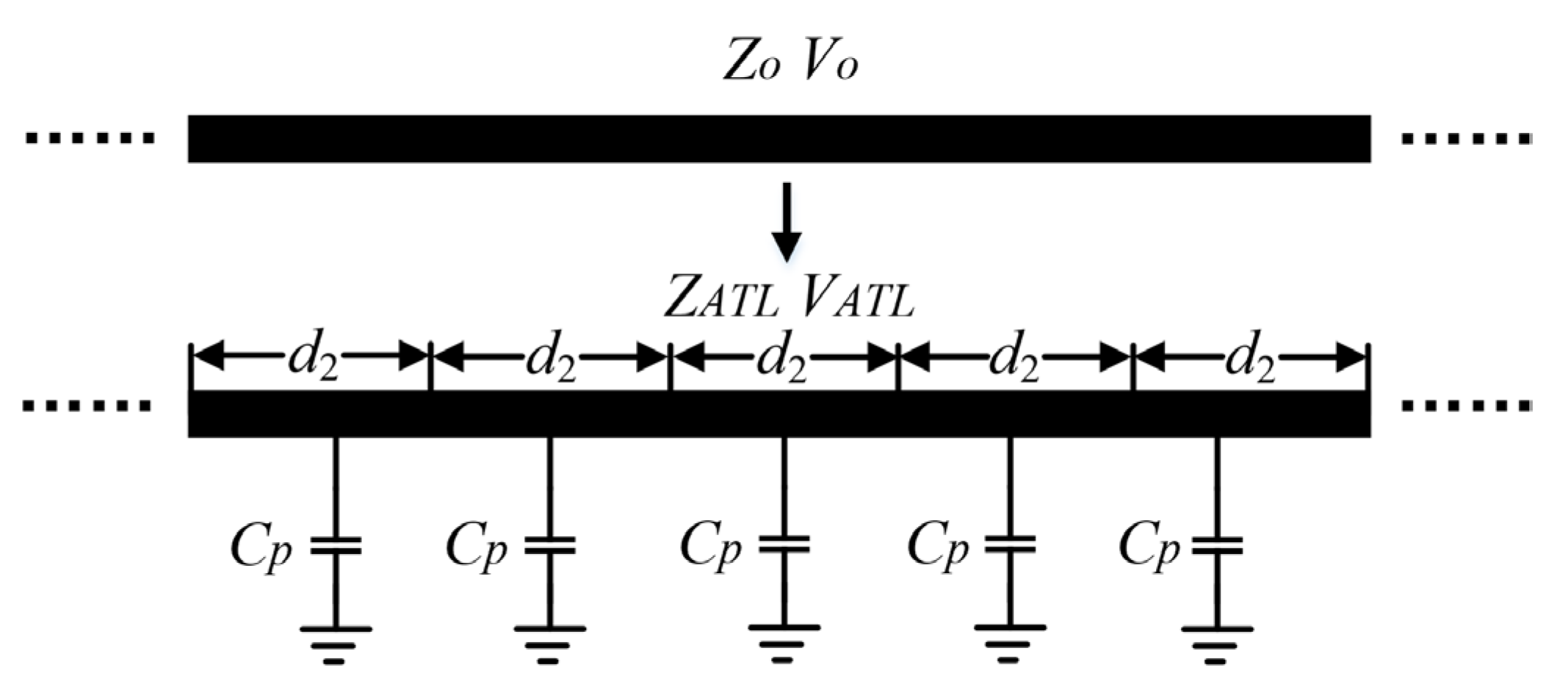


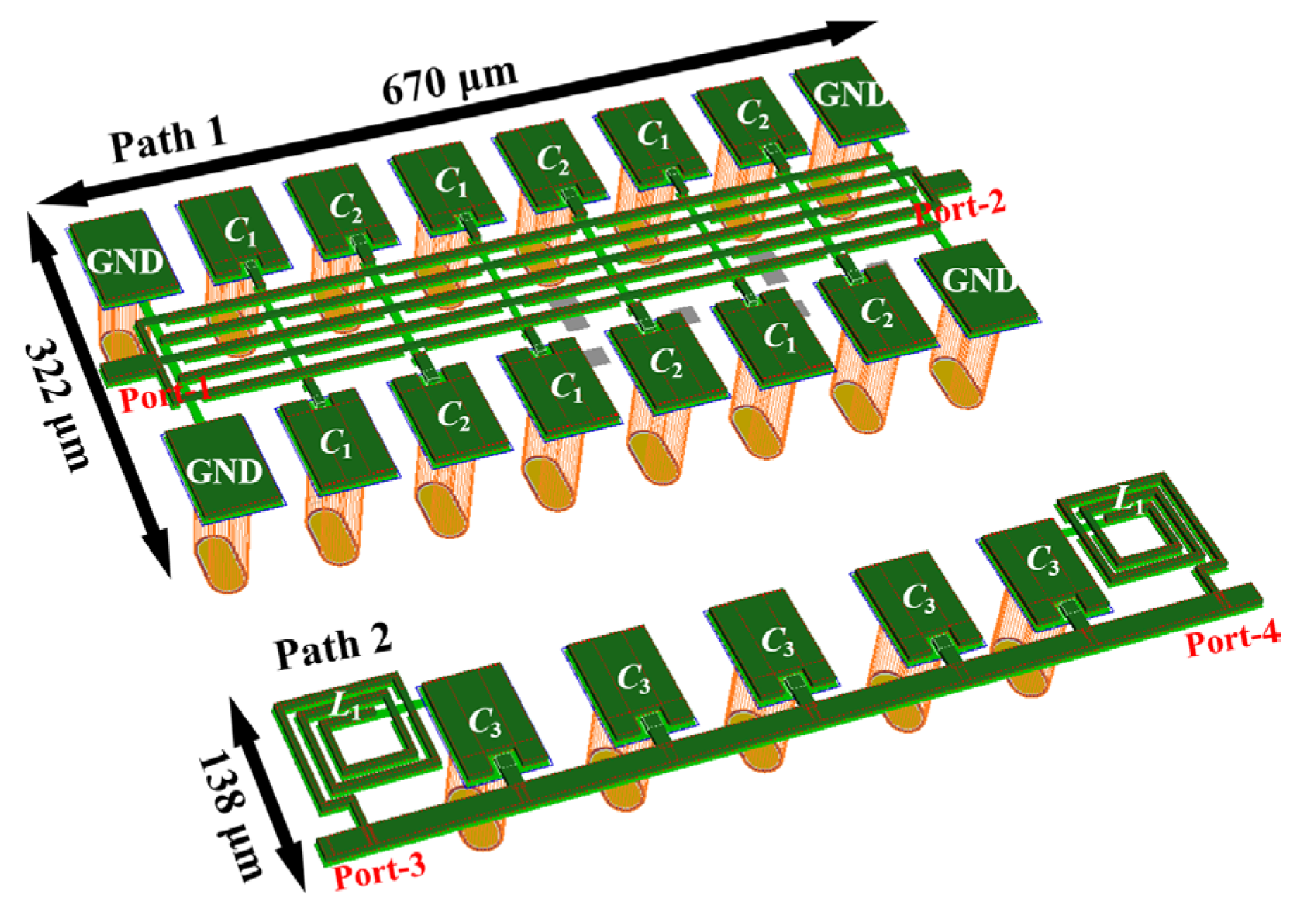
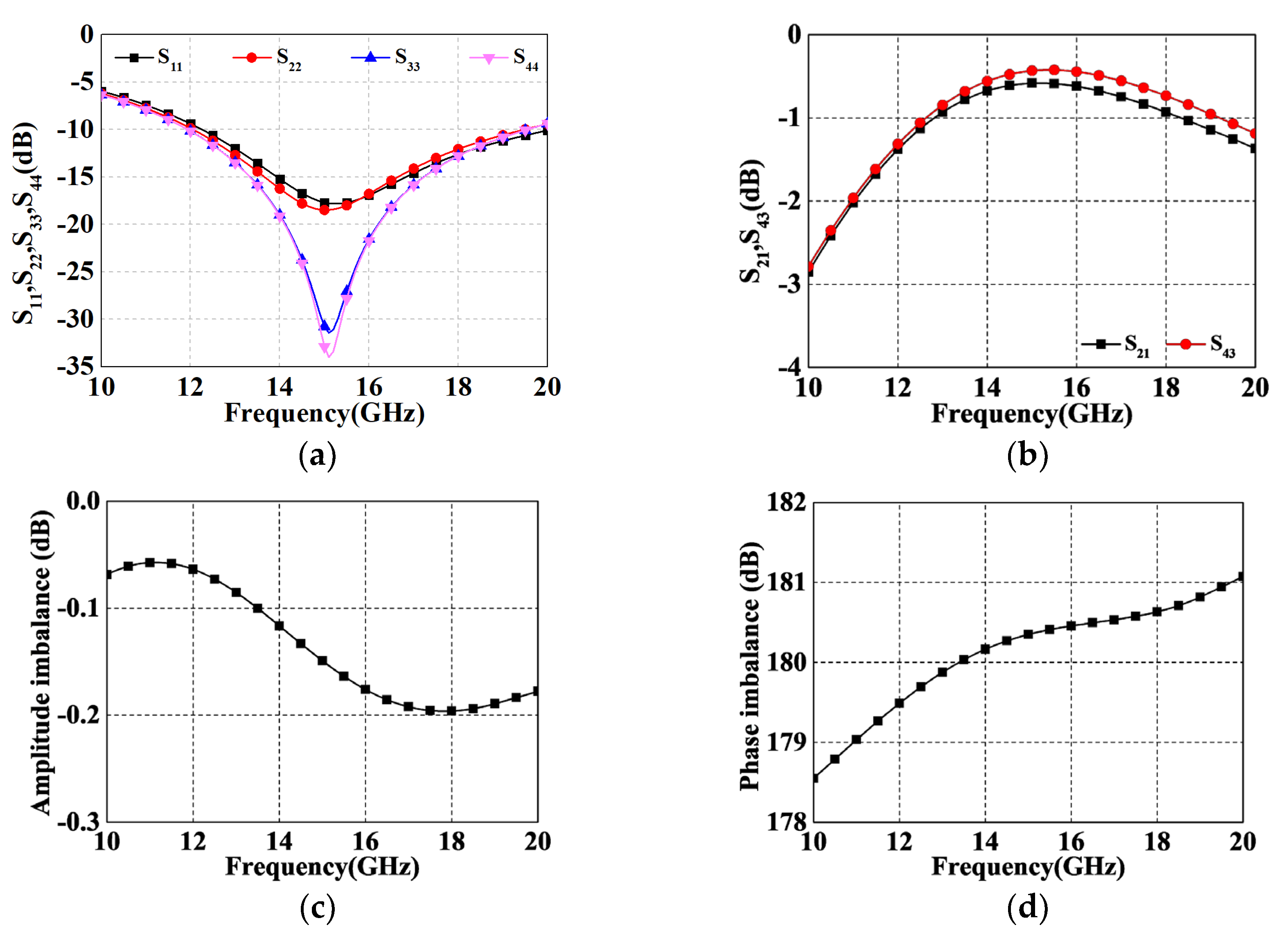
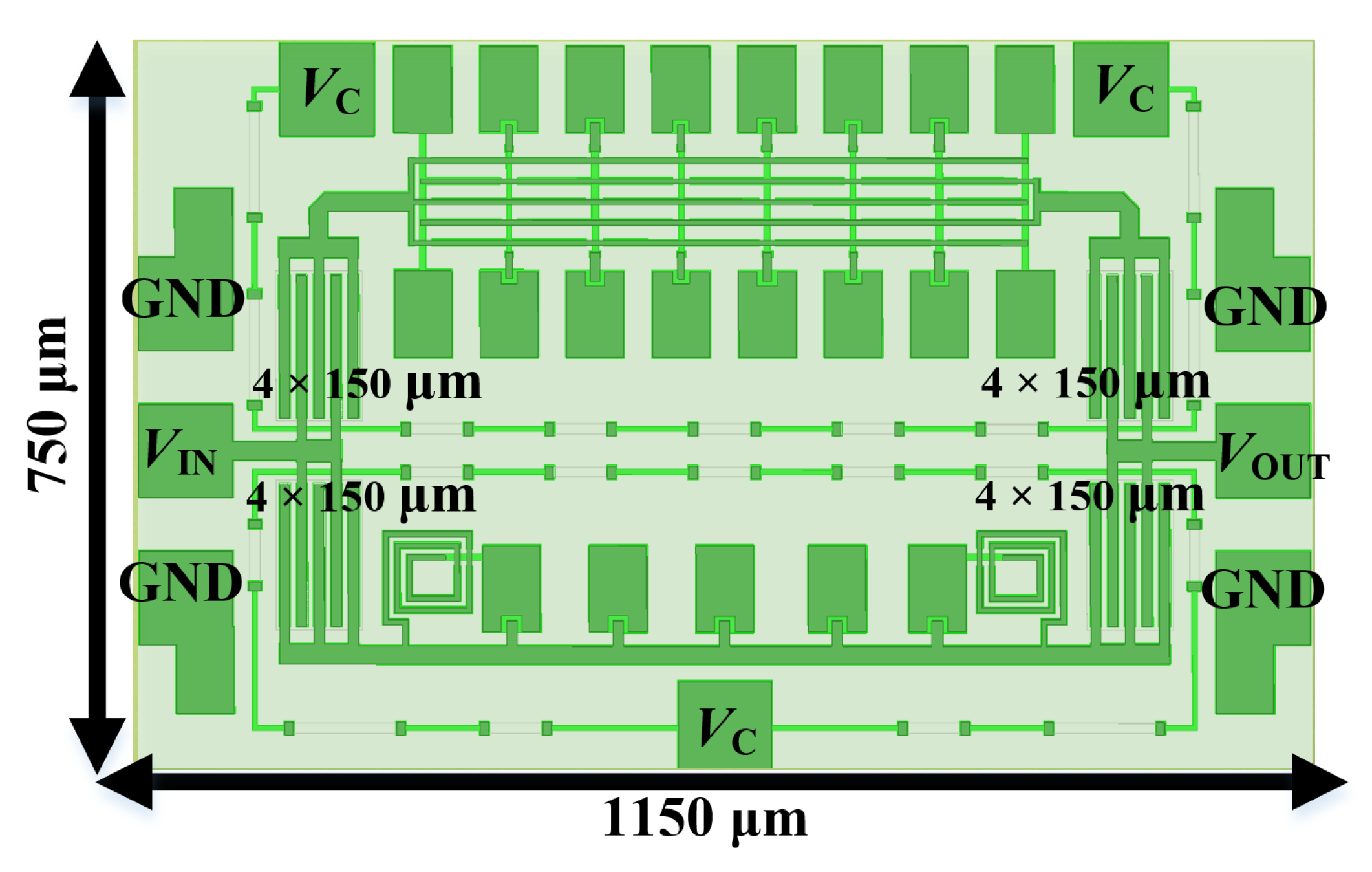
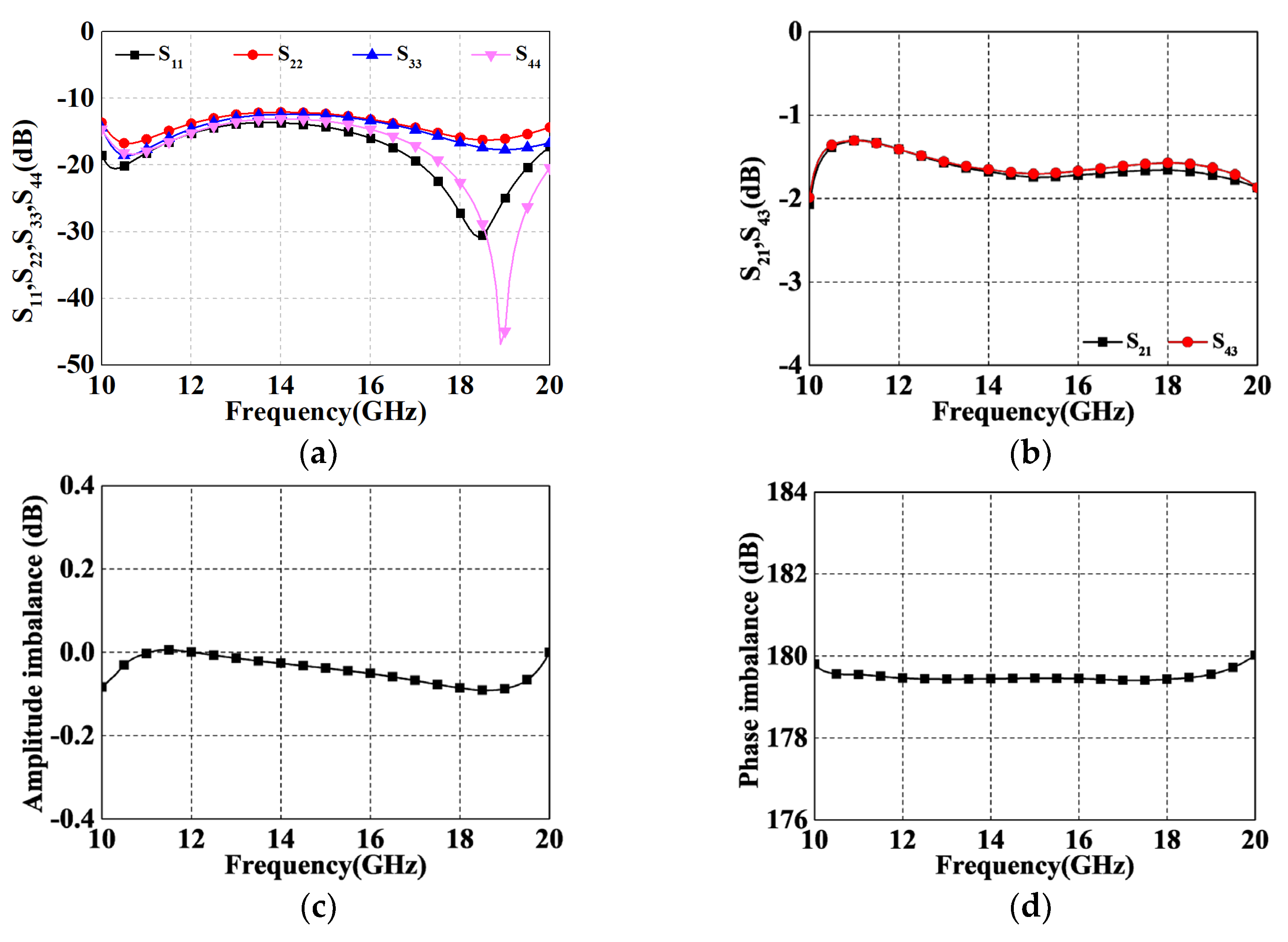
| W1 + (Cs +) | W1 − (Cs −) | d1 + (Cm −) | d1 − (Cm +) | n + | n − | |
|---|---|---|---|---|---|---|
| C | − | + | − | + | + | − |
| Ref | Freq. (GHz) | RL (dB) | AI (dB) | Phase Shift (deg) | Techniques | Size () |
|---|---|---|---|---|---|---|
| [20] | 1.14–2.79 | 15 | N/A | 183 ± 2 | parallel-coupled 3-line | 0.0625 |
| [26] | 2.15–4.3 | 13.5 | N/A | 180 ± 4.5 | parallel-coupled-line filter | 0.192 |
| [27] | 1.6–2.4 | 7.5 * | <0.25 | 180 ± 4.2 | edge-coupled delay line | 0.258 |
| [28] | 3.12–3.96 | 15 | N/A | 180 ± 8 | slotted substrate waveguide | 1.8 |
| [29] | 1.45–3.28 # | 10 | N/A | 180 ± 1.5 | Slotlines-based Schiffman | 0.5 |
| [30] | 8–11 | 10 | N/A | 180 ± 4.5 | high/low pass | 0.063 |
| [31] | 12–18 | 17.5 | N/A | 180 ± 6 | high/low pass | 0.11 |
| This work $ | 10–20 | 12 | <0.1 | 179.7 ± 0.3 | ECMML & ATL | 0.0154 |
Disclaimer/Publisher’s Note: The statements, opinions and data contained in all publications are solely those of the individual author(s) and contributor(s) and not of MDPI and/or the editor(s). MDPI and/or the editor(s) disclaim responsibility for any injury to people or property resulting from any ideas, methods, instructions or products referred to in the content. |
© 2023 by the authors. Licensee MDPI, Basel, Switzerland. This article is an open access article distributed under the terms and conditions of the Creative Commons Attribution (CC BY) license (https://creativecommons.org/licenses/by/4.0/).
Share and Cite
He, D.; Fan, J.; Zhu, Z.; Yuan, Y.; Yu, Z. Compact Bandwidth-Enhanced 180-Degree Phase Shifter Using Edge-Coupled Multi-Microstrip and Artificial Transmission Line. Micromachines 2023, 14, 1692. https://doi.org/10.3390/mi14091692
He D, Fan J, Zhu Z, Yuan Y, Yu Z. Compact Bandwidth-Enhanced 180-Degree Phase Shifter Using Edge-Coupled Multi-Microstrip and Artificial Transmission Line. Micromachines. 2023; 14(9):1692. https://doi.org/10.3390/mi14091692
Chicago/Turabian StyleHe, Ding, Jingxin Fan, Zhiqiang Zhu, Yang Yuan, and Zhongjun Yu. 2023. "Compact Bandwidth-Enhanced 180-Degree Phase Shifter Using Edge-Coupled Multi-Microstrip and Artificial Transmission Line" Micromachines 14, no. 9: 1692. https://doi.org/10.3390/mi14091692
APA StyleHe, D., Fan, J., Zhu, Z., Yuan, Y., & Yu, Z. (2023). Compact Bandwidth-Enhanced 180-Degree Phase Shifter Using Edge-Coupled Multi-Microstrip and Artificial Transmission Line. Micromachines, 14(9), 1692. https://doi.org/10.3390/mi14091692








